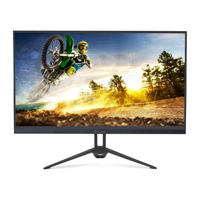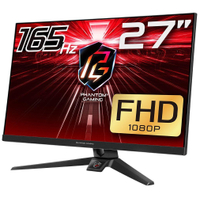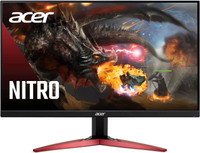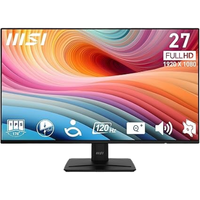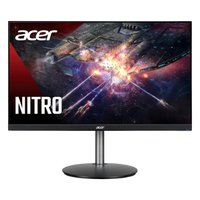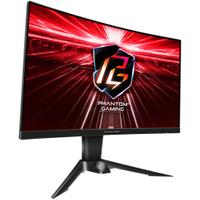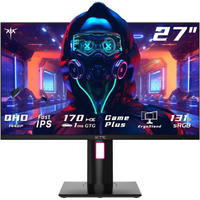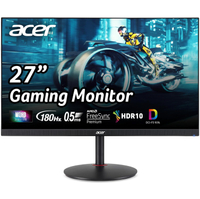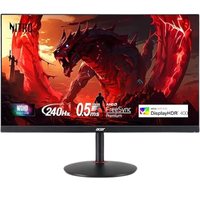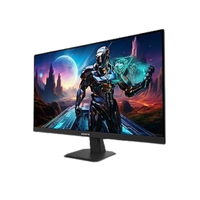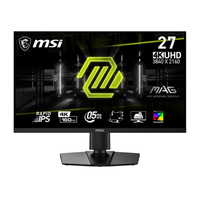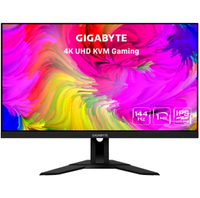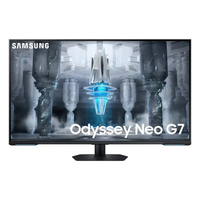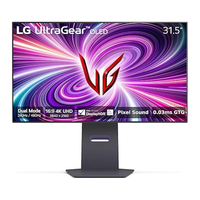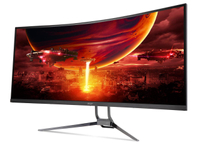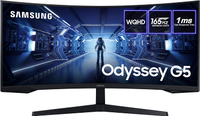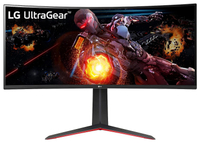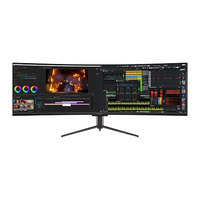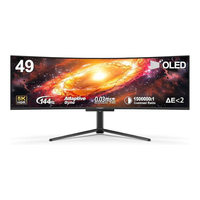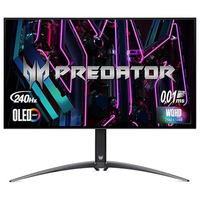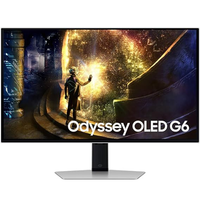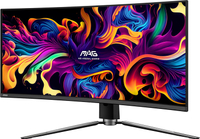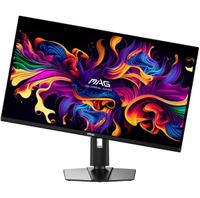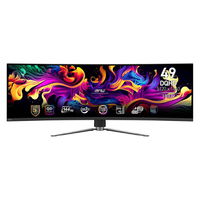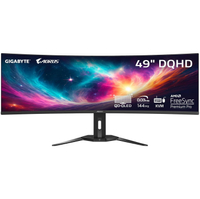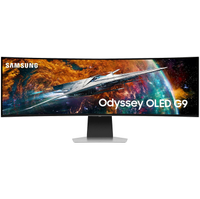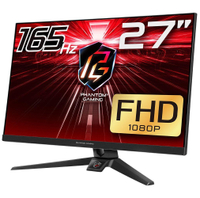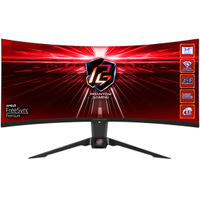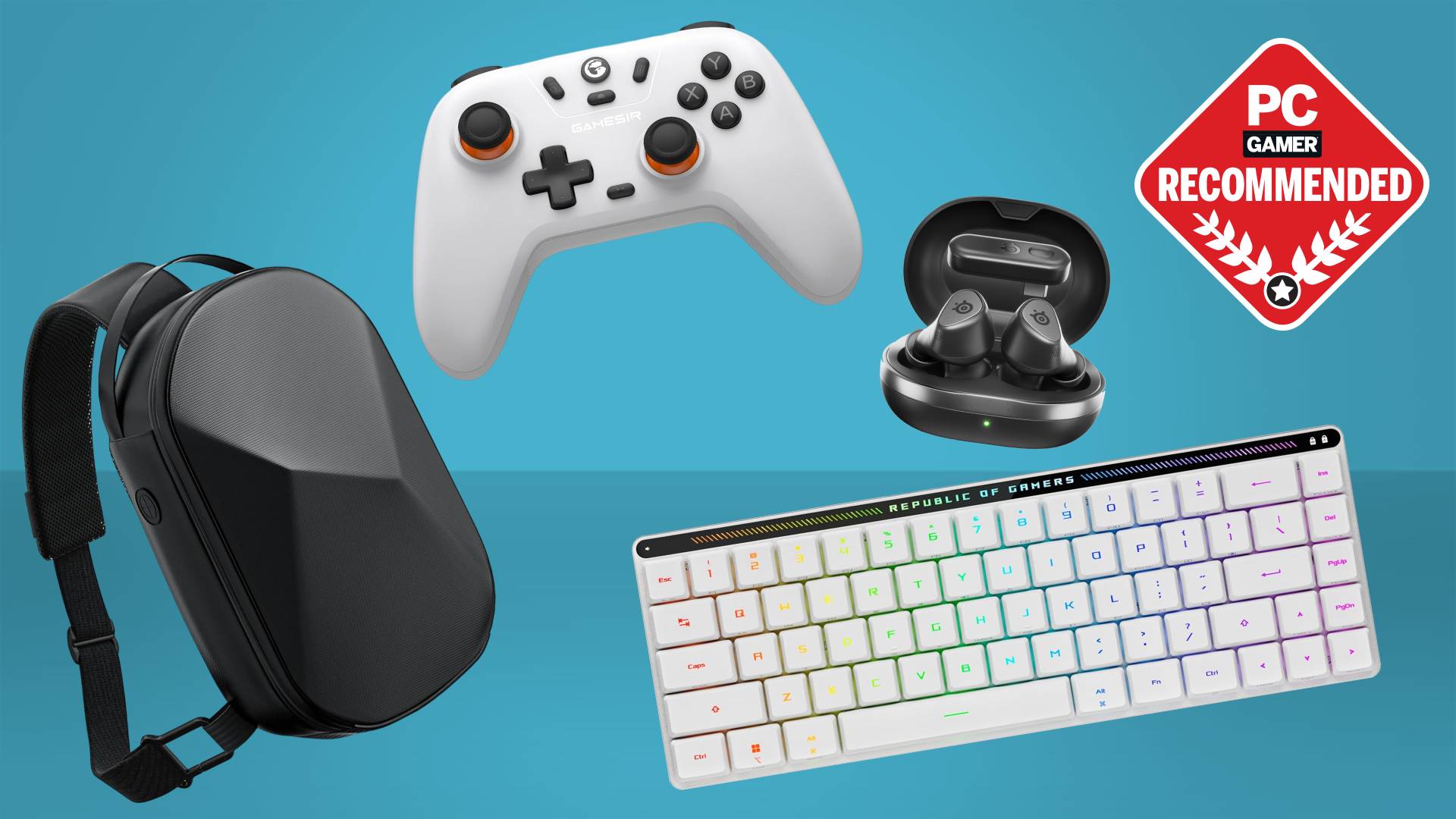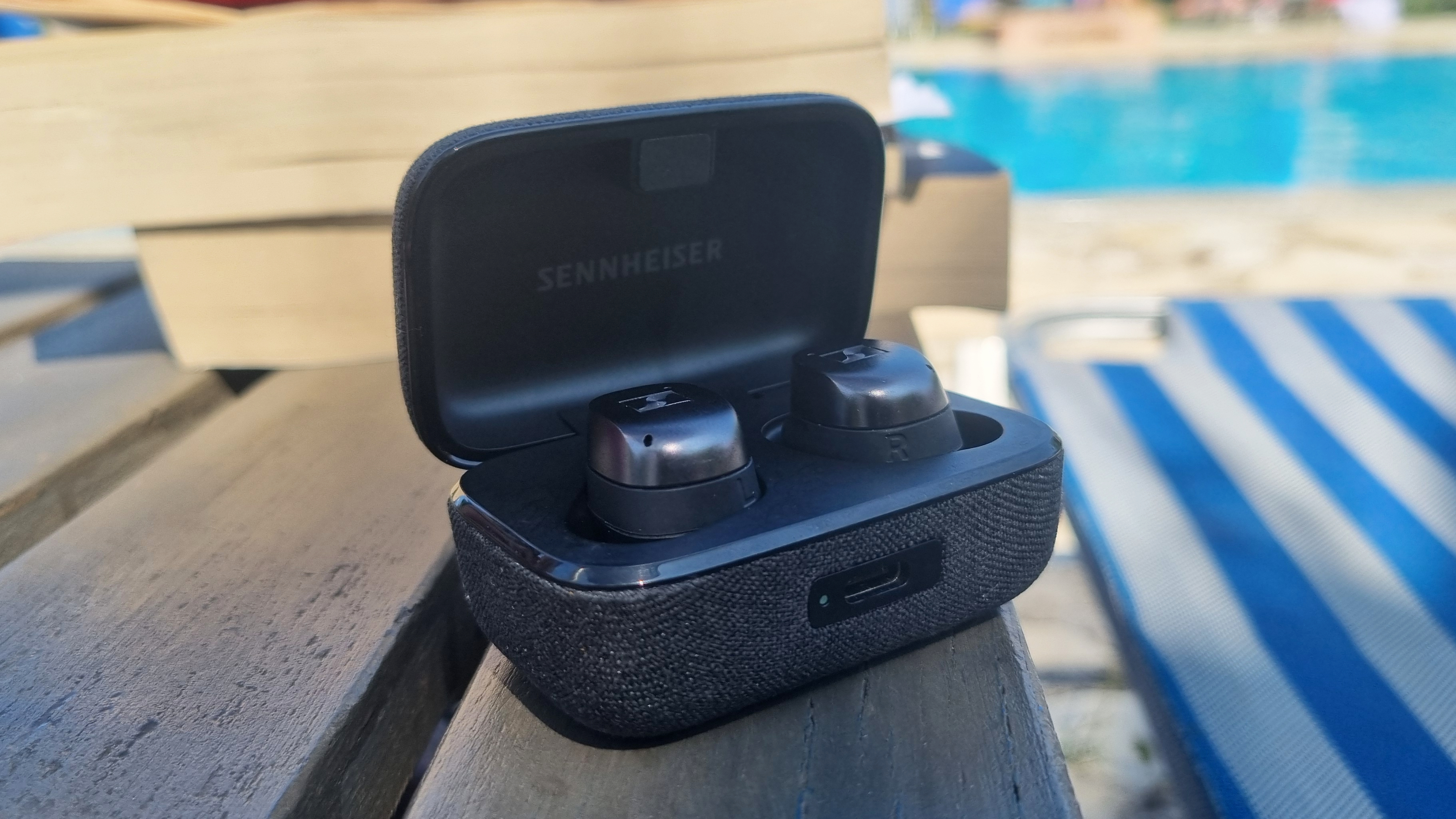Best cheap gaming monitor deals today
We've scoured the internet for the best deals on gaming monitors, so you don't have to.
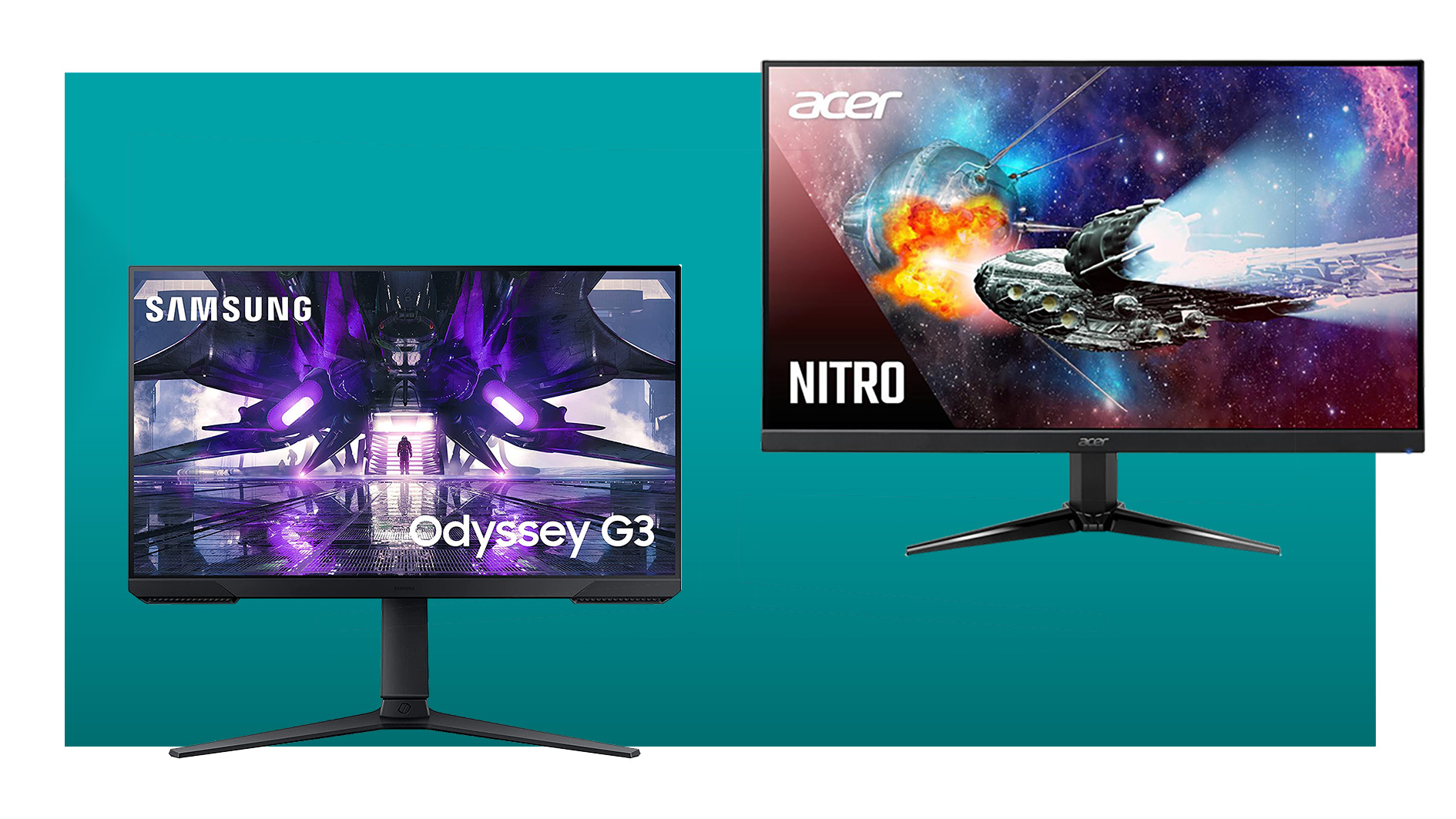
1. 1080p: 1920 x 1080 (HD)
2. 1440p: 2560 x 1440 (QHD)
3. 4K: 2840 x 2160 (UHD)
4. Ultrawide: 3440 x 1440 (WQHD), 2560 x 1080 (WFHD)
5. OLED: QD-OLED, WOLED
6. UK monitor deals: All the best panels on sale
There are plenty of cheap gaming monitor deals around at any one point; we would know, we're constantly updating this page with them. Whether you're looking to upgrade to a higher resolution screen because you've just bagged a shiny new graphics card or adding a second panel to your home office desk, there's usually a lot on offer at discount prices.
If you've picked up one of the best graphics cards, you must ensure your monitor can deliver its optimum resolution with a decent frame rate. Otherwise, you're not taking advantage of your fancy GPU's graphical potential and forcing an unnecessary bottleneck.
For the discerning competitive gamer, it's all about frame rate. Resolution be damned! Thankfully, we've spotted gaming monitors with refresh rates up to 270Hz on offer lately, and 144 Hz now seems to be the standard minimum.
We've compiled a list of all the best cheap gaming monitor deals we've found, using our years of panel testing expertise to guide us, and we've organized them by resolution below. You can also see how they compare against some of the best gaming monitors. Those top screens don't always go on sale, but the ones listed here can offer a good alternative if you want to save a buck. Rest assured, we will let you know if they get a discount.
What does 'price watch' mean?
We've added a new "price watch" qualifier to all our individual deals, making it easy to see whether a price has gone up 🔼 or down 🔽 since we last checked it out. It's important to note that any deal in this guide (even if it's slightly risen in price) is still one of our top picks, as we only show you deals that are actually worth buying.
Gaming monitor deals — US quick links
- 1080p: Acer AOPEN | $85 @ Newegg
- 1440p: Asus 27-inch 170 Hz | $170 @ Newegg
- 4K: Asus TUF 27-inch | $350 at Amazon
- Ultrawide: Acer Nitro 34 UWQHD | $290 @ Amazon
- OLED: ASRock Phantom 27-inch 360 Hz QD-OLED | $550 @ Newegg
- Amazon: Acer Nitro 24-inch Full HD monitor for $110
- Best Buy: Acer Nitro 24-inch 1080 200 Hz for $140
- Newegg: Acer AOPEN 1080p for $85

1080p
Price watch: NEW DEAL!
Acer AOPEN | 23.8-inch | 1080p | 180 Hz | 1 ms | $129.99 $84.99 (save $45 at Newegg)
The absolute cheapest monitor we'd recommend right now, this little Acer AOPEN screen has a nice high refresh rate and solid response time for its price point.
Price watch: ➖
ASRock Phantom PG27F15RS1A | 27-inch | 1080p | 240 Hz | IPS | FreeSync | $189.99 $104.77 at Newegg (save $85.22)
ASRock has become a favorite of ours around here over busy shopping periods. These screens always seem to be on offer, and from the one we've used (read our review) they're good value for the money, too. This one is currently backordered so it may take a little while to show up though.
Price check: Not in stock at Walmart or Amazon
Price watch: ➖
Acer Nitro KC241Y Sbiip | 23.8-inch | 1080p | 165 Hz | VA | $172.99 $109.99 at Amazon (save $67)
Why do monitor model names need to be so confusing? It's an eternal mystery. But if you can decode this Acer, you'll find it's a cracking deal. A 165 Hz gaming monitor for just over $100. Yes, it's VA, but at this price point, something's gotta give.
Price check: Newegg $145
Price watch: ➖
MSI Pro MP27IA E2 | 27-inch | 1080p | 120 Hz | 1 ms | $134.99 $109.99 at Amazon (save $35)
With this specific MSI Pro model, you are taking a larger panel for a lower refresh rate. However, you also get built-in speakers for your troubles. It's a solid choice for anyone looking for a budget all-rounder. We have seen it a little cheaper before, though.
Price check: Newegg $129.99
Price watch: ➖
Acer Nitro XF273 M3bmiiprx | 27-inch | 180 Hz | 0.5 ms | $199.99 $129.99 at Acer (save $70)
27 inches, 180 Hz refresh rate, and a 0.5 ms response time—this is almost everything you may want from a 1080p screen, and it is at a good price. This Acer monitor may have a funny name, but its specs don't play around.
Price check: Best Buy $212.99
1440p
Price watch: ➖
ASRock Phantom PG27Q15R2A | 27-inch | 1440p | 165 Hz | VA | $239.99 $142.77 at Newegg (save $97.22)
ASRock's gaming monitors are always so darned cheap—we love them for that. This 1440p panel offers resolution and a rapid refresh rate for a potent PC gaming combo, though the built-in Wi-Fi antenna helps it stand out from the crowd. That's hardly essential, but could come in useful for some.
Price check: Amazon not in stock
Price watch: ➖
Acer KA272U | 27-inch | 1440p | 100 Hz | IPS | $199.99 $149.99 at Best Buy (save $50)
If you're on the tightest of budgets, this will get you a decently sized 1440p monitor for a real bargain price. It even has a higher-than-60 Hz refresh rate. Okay, 100 Hz isn't spectacular, but it is still notably smoother than 60 Hz. It's also not the brightest screen, rated at 250 nits peak, but the compromises will have to come in somewhere.
Price check: Amazon not in stock
Price watch: NEW DEAL!
KTC H27T22 | 27-inch | 1440p | 165 Hz | 1 ms | $289.99 $169.99 (save $120)
Cheap and cheerful sums up this monitor well. With a max refresh rate of 165 Hz, a 1 ms response time, and 1440p resolution, it has what you need out of a budget 1440p option. Its panel isn't the brightest, and you will get a more vibrant screen out of a more expensive option, but it's a solid choice for the price.
Price watch: ➖
Acer Nitro XV271U M3bmiiprx | 27-inch | 1440p | 180 Hz | IPS | $289.99 $199.99 at Amazon (save $90)
This Acer monitor is a steal for all you prospective competitive gamers, hitting a high refresh rate and low response time sweet spot (0.5-1 ms gray-to-gray). It's the same price as the Odyssey G5 below but is better for those of you who prefer an IPS panel to a VA.
Price check: Acer $199.99 | Newegg $238
Price watch: NEW DEAL!
Samsung Odyssey G5 G55C | 27-inch | 1440p | 165 Hz | VA | Curved | $299.00 $219.99 at Newegg (save $79.01)
This monitor was already a great deal at its previous price. Now, for just over $200, it's even better. Samsung has form when it comes to getting VA panels to achieve good response. Put simply, Samsung VA panels are the quickest. It is, however, a little more expensive than we've seen this monitor sell for before. It's still a good deal despite that.
Price watch: ➖
Acer Nitro XV272U W2bmiiprx | 27-inch | 1440p | 240 Hz | 0.5 ms | $299.99 $229.99 at Amazon (save $70)
Acer's $200+ 1440p shows its more premium price point in an up to 240 Hz refresh rate and up to 0.5 ms response time. Both of these combine to make a very smooth gaming experience. You just need to make sure you have a good enough rig to match the refresh rate with your fps.
Price check: Acer $229.99
4K
Price watch: ➖
Gigabyte GS27U | 27-inch | 4K | 160 Hz | $349.99 $299.99 at Amazon (save $50)
Gigabyte is a staple of the budget 4K monitor market, and the biggest reason it gets removed from our deals list is that it occasionally sells out. This 27-inch 4K panel is a great price, with some good specs to go alongside it.
Price check: Newegg $299.99
Price watch: 🔽
MSI MAG 274UPF | 27-inch | 4K | 160 Hz | 1 ms | $399.99 $339.99 at Best Buy (save $60)
This MSI MAG is the cheapest 4K gaming monitor we'd recommend right now, and the smallest at just 27 inches. Despite its size, it holds some mighty specs, with a fast refresh rate and that high-resolution panel.
Price watch: 🔽
Gigabyte M28U | 28-inch | 4K | 144 Hz | IPS | $599.99 $329.99 at Newegg (save $270)
Here's a monitor we really rate from our Gigabyte M28U review. We actually loved this package for its blend of speed and resolution, even at its original $650 price tag. At this tantalizingly cheap price, it's that much better.
Price check: Amazon sold out
Price watch: ➖
Samsung Odyssey Neo G7 | 43-inch | 4K | UHD | 144 Hz | 1 ms | $999.99 $499.99 at Best Buy (save $500)
A bit of an oddity is this Odyssey. A 43-inch 4K monitor, it's a sizeable old beast, but you get quite good specs for that large panel. If you have the desk space for it, the lovely screen, relatively strong refresh rate, and solid response time make it a cracking addition to a setup.
Price watch: ➖
LG 32GS95UE | 32-inch | OLED | 4K | 240 Hz | 0.03 ms | $1,399.99 $1,096.99 at Amazon (save $303)
Okay, this monitor is quite expensive, but it's one of our absolute favourites for a reason. A gorgeous OLED 4K screen, with a 240 Hz refresh rate, and 0.03 ms response time. It has everything you may want from a modern monitor, and looks good while it does it.
Ultrawide
Price watch: ➖
Acer Nitro EDA343CUR V3bmiippx | 34-inch | 3440 x 1440 | 180Hz | VA | $319.99 $289.99 at Amazon (save $40)
Yes, this is the Acer Nitro EDA343CUR V3bmiippx, not the Acer Nitro EDA343CUR Hbmiippx. Totally ridiculous naming, but the V3bmiippx as opposed to Hbmiippx indicates 180 Hz as opposed to 100 Hz. And that's a lot of Hz on a 34-inch ultrawide for under $300.
Price check: Newegg $405.99
Price watch: ➖
Samsung Odyssey G5 | 34-inch | 3440 x 1440 | 165 Hz | VA | Curved | $399.99 $329.99 at Amazon (save $70)
34-inch ultrawide 1440p gaming remains one of our firm favourites. It's a great compromise between lots of detail and decent frame rates. This Samsung panel gives you all that with 3,440 by 1,440 pixels, 165 Hz refresh, and 1 ms response, alongside a light curve. It's not the brightest at 250 nits. But if you can live with that, it's an awful lot of monitor for the money.
Price check: Best Buy $349.99
Price watch: 🔽
LG UltraGear 34GP63A-B | 34-inch | 3440 x 1440 | 160 Hz | VA | Curved | $399 $349.99 at Amazon (save $50)
At its current price, this LG ultrawide is a genuine bargain (though not as good as it has been before). By comparison, Alienware's fancy QD-OLED 34-inch panel is around $800 even on sale. This LG matches its size, resolution, aspect ratio, and refresh rate for less than one-third of the price, although, of course, it is a VA panel, not an OLED. It's also not the brightest gaming monitor ever, but it is a very good deal.
Price check: LG $349.99
Price watch: ➖
Innocn 49 WDFHD | 49-inch | 144 Hz | 32:9 | 3840 x 1080 | $749.99 $594.99 at Amazon (save $155 for Prime members)
This INNOCN 49-inch curved monitor is quite impressive, with a 144 Hz refresh rate, built-in speakers, and HDR 400 compatibility. At 3840 x 1080, it's not quite as impressive as the INNOCN below, but much better on the wallet. This is a Prime member price, so you need Amazon Prime to access it.
Price watch: ➖
Innocn 49Q1R | 49-inch | 5120 x 1440p | 144 Hz | Curved | $999.99 $774.99 at Amazon (save $225 for Prime members)
Though the sale on Amazon says this monitor retails for $999.99, Innocn's site originally says it retailed at $1,199.99, so you might actually be getting an even better deal than we thought. Either way, getting an OLED 1440p 49-inch ultrawide monitor for this much is super solid, and explains why it's the only monitor we're highlighting at this price point. This is, unfortunately, a Prime Member deal, so you need Prime to grab it for yourself.
Price check: Innocn $799.99
OLED
Price watch: ➖
Acer Predator X27U X1Bmiiphx | 27-inch | 2560 X 1440 | 240 Hz | OLED | $599.99 $549.99 at Newegg(save $50)
Both 1440p and OLED, this 27-inch monitor from Acer has almost everything you may want to pair with your rig. It's even better now that it's $50 off, making it the cheapest OLED on our entire list right now (though it has been cheaper than this before). To top it off, it comes with a 240 Hz refresh rate, up to 0.01 ms response time, and a solid selection of ports with a DisplayPort, 2 HDMI ports, and USB Type-C.
Price check: Amazon $549.99
Price watch: ➖
Samsung Odyssey G61SD | 27-inch | 2560 x 1440 | 240 Hz | OLED | $799.99 $649.99 at Amazon (save $150)
Samsung's 27-inch 240 Hz screen is now $200 off, making it the perfect choice for someone who wants their games to look great but has limited space for their monitor. This can get down to a blazing fast 0.03 response time, making it great for gaming.
Price watch: ➖
MSI MAG 341CQP | 34-inch | 3440 x 1440 | 175 Hz | QD-OLED | Curved | $779.99 $699.99 at Newegg (save $80)
OLED gaming still isn't as affordable as we'd like. But it's getting there. This 34-inch ultrawide QD-OLED beast is still a good deal at this price, however. The 175 Hz refresh is a tiny bit pedestrian, but it's plenty fast enough for us, and in all other regards, this is the full OLED experience, including 0.03 ms response and serious HDR sizzle.
Price watch: NEW DEAL!
MSI MAG 321UP | 32-inch | 4K | 165 Hz | QD-OLED | $829.99 $769.99 at Amazon (save $60)
What a difference a letter makes... especially when it comes to gaming monitors. The code names given to monitors are often impenetrable, but the difference between this MAG 321UP and the MAG321UPX is that this one has a 165 Hz refresh instead of 240 Hz. That's the only difference between this and the more expensive one. If you're not concerned about the refresh rate difference (and do you have the hardware to hit a matching 240 fps otherwise?), then this is where the smart OLED money is spent.
Price check: Newegg $799.99
Price watch: ➖
MSI MPG 491CQP | QD-OLED | 49-inch | Curved | 5120 x 1440 | 144 Hz | $1,099.99 $899.99 at Amazon (save $200)
A 49-inch curved QD-OLED gaming monitor may be too much for some, but if you're the type of person to like all those adjectives, this MSI screen at $200 off is a great deal. You just need to make sure you actually have the desk space for it.
Price check: Newegg $899.99
Price watch: ➖
Gigabyte Aorus CO49DQ | 49-inch | 5120 x 1440 | 144Hz | QD-OLED | Curved | $1,099.99 $891.99 at Best Buy (save $208)
The Gigabyte Aorus CO49DQ is a lot of monitor for the money, as we found in our review. Those rocking the RTX 4090 might be better off with the higher refresh rate of the Samsung Odyssey G9 G93SC, but the rest of us can take advantage of this very wide, very pretty-looking panel for a bit less.
Price check: Amazon sold out
Price watch: 🔽
Samsung Odyssey G9 G95SC | 49-inch | 5120 x 1440 | 240 Hz | OLED | Curved | $1,799.99 $999.99 at Amazon (save $800)
All evidence points to this being a computer monitor, but let's be real: This is a surfboard that can display moving pictures. An extremely nice surfboard, to be sure: You're getting just about every bell and whistle you could want in an ultra-ultrawide monitor at the steepest discount we've seen.
Price check: Samsung $1,799.99
Gaming monitor deals — UK quick links
- 1080p: Asus TUF 24-inch | £103 Overclockers
- 1440p: MSI G272QPF | £159 @ Amazon
- 4K 144 Hz: LG UltraGear | £450 at Amazon
- Ultrawide: AOC Gaming CU34G2XP | £229 @ Amazon
- OLED: Gigabyte M027Q2 | £450 at Amazon
- Amazon: Tons of deals on gaming monitors
- Ebuyer: MSI MAG 27CQ6F 27-inch 2K gaming monitor for £159
- Overclockers: 1080p panels for around £100
- Currys: Up to £180 savings on gaming monitors
- Argos: HP Omen 165Hz IPS 1080p for £139
UK monitor deals
Price watch: ➖
ASRock Phantom PG27FF1A | 27-inch | 1080p | 165 Hz | IPS | £123.95 at Overclockers
It's pretty wild what you can get these days for a relatively small sum of money. This is a 27-inch monitor for roughly the same price as some smaller 24-inch panels, and it still rocks an IPS display, 1ms response time, and a 165 Hz refresh rate. Fantastic for gaming on a budget.
Price check: Amazon £122.27
Price watch: ➖
AOC CU34G2XP | 34-inch | 3440 x 1440 | 180 Hz | VA | £329.99 £228.95 at Amazon (save £101.04)
If you thought decent ultrawides were expensive, I'm happy to prove you wrong. VA panel, of course, but otherwise this wide boi has very little wrong with it for the cash. That 180 Hz refresh rate is very nice to see at this price.
Price watch: ➖
LG UltraGear 32GR93U | 32-inch | 4K | 144 Hz | IPS | £649.99 £426.27 at Amazon (save £223.72)
LG makes some of our favourite gaming monitors, and this 4K IPS panel is part of its UltraGear line, of which we are very much fans. The 144 Hz refresh rate might not be the fastest, but it's still plenty speedy for most, and otherwise, this panel has near-flawless specs for the cash. Okay, it's not an OLED, but that's some serious extra cash to spend.
Price watch: NEW DEAL!
MSI MAG 341CQP | 34-inch | 3440 x 1440 | 175 Hz Hz | OLED | £899 £649.99 at Amazon (save £250.01)
OLED tech is where it's at for the best gaming monitors, and this 34-inch curved ultrawide is built to absolutely stun. With lush colours and gorgeously deep black levels, OLED is where you want to be if you've got the cash. This MSI model is cheaper than the rest, plenty fast, and will look fantastic on your desk.
Price watch: ➖
ASRock Phantom PG34WQ15R2B | 34-inch | 3440 x 1440 | 165 Hz | VA | Curved | £269.99 at Scan
You can't beat a high-refresh 34-inch ultrawide gaming panel in terms of bang for buck and ASRock gives you that particular bang for less buck than ever. As we found in our review, this 1 ms 165 Hz VA panel has no major weaknesses and makes for a really nice overall package for the money.
Price Check: Overclockers £329.99
Price watch: 🔽
MSI MAG 321UP | 32-inch | 4K | 165 Hz | QD-OLED | £949 £698.99 at Amazon (save £250.01)
What a difference a letter makes... especially when it comes to gaming monitors. The code names given to monitors are often impenetrable, but the difference between this MAG 321UP and the MAG321UPX is that this one has a 165 Hz refresh instead of 240 Hz. That's the only difference between this and the more expensive one. If you're not concerned about the refresh rate difference (and do you have the hardware to hit a matching 240 fps otherwise?,) then this is where the smart OLED money is spent.
Check out our dedicated WhatsApp channel for the latest PC hardware deals.
Gaming monitor FAQ
Should I go for an IPS, TN or VA panel?
We would always recommend an IPS panel over TN. The clarity of image, viewing angle, and color reproduction is far superior to the cheaper technology, but you'll often find a faster TN for cheaper. The other alternative, less expensive than IPS and better than TN, is VA tech. The colors aren't quite so hot, but the contrast performance is impressive.
Should I go for a FreeSync or G-Sync monitor?
In general, FreeSync monitors will be cheaper. It used to be the case that they would only work in combination with an AMD GPU. The same went for G-Sync monitors and Nvidia GPUs. However, it is possible to find G-Sync-compatible FreeSync monitors if you intend to spend less.
Should I buy a HDR monitor?
With a High Dynamic Range monitor, you can take advantage of the ever-growing list of games and apps with HDR support. It offers more vibrant colors and greater contrast but will slightly increase the price. Windows' native HDR function also leaves much to be desired, and you may have to fiddle with the settings to get HDR looking like it should.
What aspect ratio should I go for?
Today's movies and games are best enjoyed in a widescreen format at a 16:9 aspect ratio or above. In 4:3, those cinematic moments will look stunted with black strips along the top and bottom. There are a host of minute variations on each ratio, but at the end of the day choosing between these depends entirely on your personal preference.
And the very far-out option, if you have a little extra cash to blow, is ultra-wide aspect ratios like 21:9 and 32:9 and their variants. These will provide a much more immersive, encompassing experience. Or literally, encompass yourself with a curved monitor, up to you.
Jargon buster - gaming monitor terminology
Refresh Rate (Hz)
The speed at which the screen refreshes. For example, 144 Hz means the display refreshes 144 times a second. The higher the number, the smoother the screen will appear when you play games.
V-Sync
Graphics tech synchronizes a game's framerate with your monitor's refresh rate to help prevent screen tearing by syncing your GPU frame rate to the display's maximum refresh rate. Turn V-Sync on in your games for a smoother experience, but you'll lose information, so turn it off for fast-paced shooters (and live with the tearing). Useful if you have an older model display that can't keep up with a new GPU.
G-Sync
Nvidia's frame synching tech that works with Nvidia GPUs. It basically allows the monitor to sync up with the GPU. It does so by showing a new frame as soon as the GPU has one ready.
FreeSync
AMD's take on frame synching uses a similar technique as G-Sync, with the biggest difference being that it uses DisplayPort's Adaptive-Sync technology which doesn't cost monitor manufacturers anything.
Ghosting
When movement on your display leaves behind a trail of pixels when watching a movie or playing a game, this is often a result of a monitor having slow response times.
Response Time
The amount of time it takes a pixel to transition to a new color and back. Often referenced as G2G or Grey-to-Grey. Slow response times can lead to ghosting. A suitable range for a gaming monitor is between 1-4 milliseconds.
TN Panels
Twisted-nematic is the most common (and cheapest) gaming panel. TN panels tend to have poorer viewing angles and color reproduction but have higher refresh rates and response times.
IPS
In-plane switching, panels offer the best contrast and color despite having weaker blacks. IPS panels tend to be more expensive and have higher response times.
VA
Vertical Alignment panels provide good viewing angles and have better contrast than even IPS but are still slower than TN panels. They are often a compromise between a TN and IPS panel.
HDR
High Dynamic Range. HDR provides a wider color range than normal SDR panels and offers increased brightness. The result is more vivid colors, deeper blacks, and a brighter picture.
Peak Brightness
This refers to the maximum brightness of a monitor or television and is measured in nits.
Ultrawide
Shorthand for monitors with aspect wider aspect ratios like 32:9 or 21:9
Resolution
The number of pixels that make up a monitor's display, measured by height and width. For example: 1920 x 1080 (aka 1080p), 2560 x 1440 (2K), and 3840 x 2160 (4K).
Keep up to date with the most important stories and the best deals, as picked by the PC Gamer team.

Dave has been gaming since the days of Zaxxon and Lady Bug on the Colecovision, and code books for the Commodore Vic 20 (Death Race 2000!). He built his first gaming PC at the tender age of 16, and finally finished bug-fixing the Cyrix-based system around a year later. When he dropped it out of the window. He first started writing for Official PlayStation Magazine and Xbox World many decades ago, then moved onto PC Format full-time, then PC Gamer, TechRadar, and T3 among others. Now he's back, writing about the nightmarish graphics card market, CPUs with more cores than sense, gaming laptops hotter than the sun, and SSDs more capacious than a Cybertruck.
You must confirm your public display name before commenting
Please logout and then login again, you will then be prompted to enter your display name.
